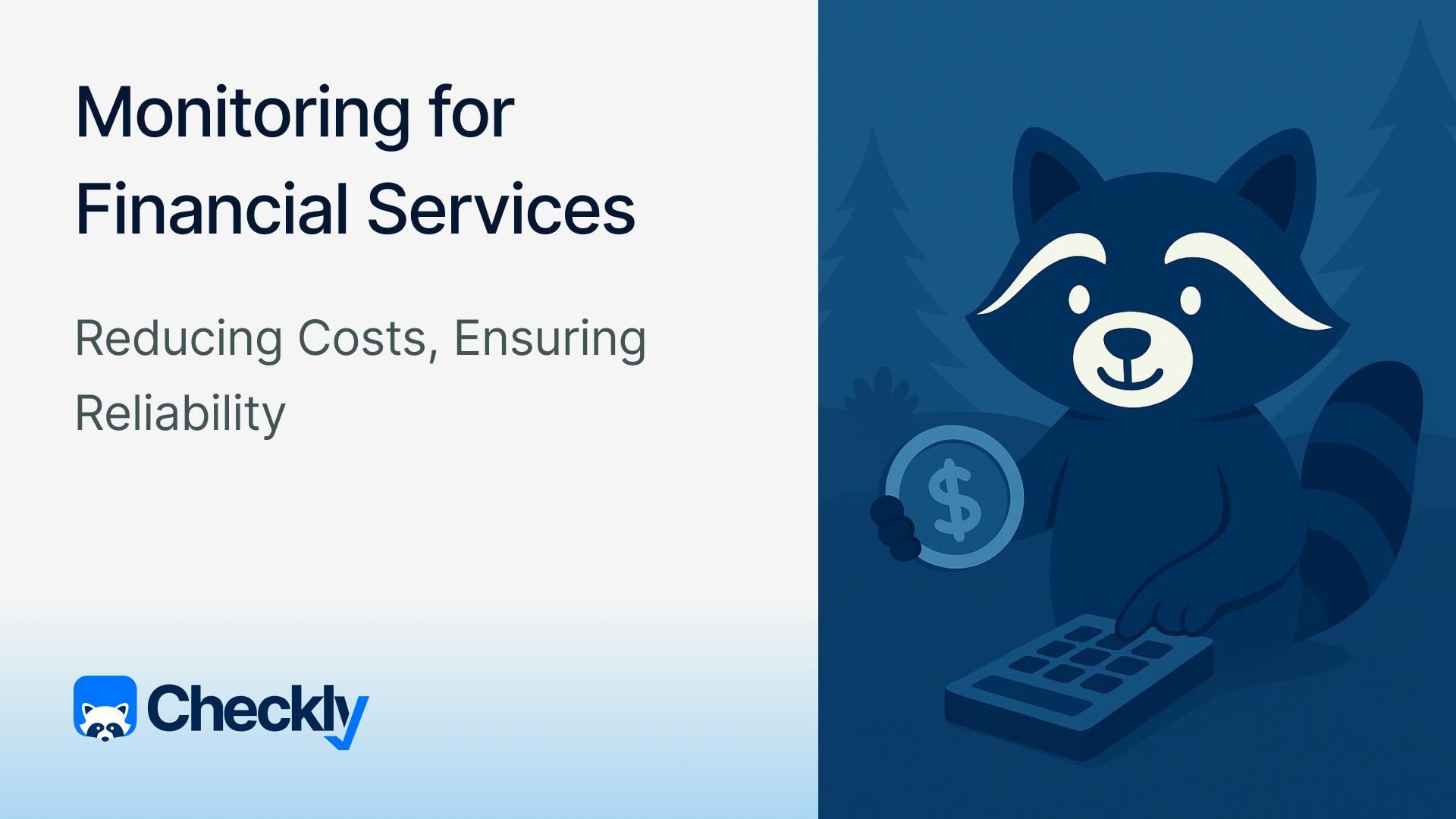Table of contents
- The Challenges of Monitoring Fintech Platforms
- From Complexity to Control: Why Monitoring Matters in Financial Services
- What Metrics You Should Monitor
- Closing the Loop: Detect, Communicate, Resolve
- How to Choose Your Fintech Monitoring Tool (Checklist)
- How TrueLayer Automated API Monitoring with 60% Less Effort
Fintech has reshaped financial services, using technologies like machine learning and blockchain to deliver faster, smarter, more user-friendly experiences. Challenger banks, open banking apps, digital payments, and investment apps have set a new standard—leaving traditional institutions racing to keep up.
But staying competitive isn’t just about building digital products—it’s about making them reliable. In fintech, even a few seconds of downtime can cost millions in revenue and years of trust. That’s why performance monitoring and observability are critical. They help teams detect issues early, prevent outages, and maintain the speed and quality customers expect.
In this article, we’ll explore how monitoring supports reliability, stability, and growth in today’s high-stakes financial services landscape. Moreover, we’ll go through the most important metrics you need to monitor as a FinTech and offer some tool options, as well as how to choose the best one for you.
The Challenges of Monitoring Fintech Platforms
Monitoring fintech systems isn’t just about tracking uptime—it’s about navigating a complex mix of technical, regulatory, and operational hurdles. Below are the key challenges teams face when trying to deliver reliable digital experiences in this high-stakes environment.
Complex, Distributed Architectures
Modern fintech platforms are built on distributed systems—microservices, APIs, and third-party components all stitched together. This modular setup enables rapid development and scale but makes it harder to get a clear picture of system health. When something breaks, pinpointing the source takes time you often don’t have.
Strict Data Sovereignty Requirements
Fintech companies frequently operate in regulated environments where data residency laws apply. Monitoring solutions must respect regional storage and processing rules, often limiting which tools you can use and where telemetry data can be sent.
Limitations on Third-Party Services
Due to security, compliance, or internal policies, many fintech organizations avoid relying on external services for monitoring or alerting. This rules out a wide range of cloud-based tools and pushes teams toward self-hosted or tightly integrated solutions.
Private Cloud and Restricted Environments
Running in a private or hybrid cloud adds complexity. Monitoring tools need to work behind firewalls, inside restricted networks, and without relying on public endpoints. This limits how and where synthetic checks or observability data can be collected.
User-Reported Errors Before System Alerts
If customers are reporting problems before your monitoring system does, something’s wrong. This usually points to gaps in coverage or monitoring blind spots—especially in critical user flows like logins, transfers, or payments.
Failures During Critical Time Windows
Timing matters. An outage during trading hours, payroll runs, or peak payment windows can do more damage than a late-night error. Monitoring strategies need to account for business-critical timing and escalate issues accordingly.
From Complexity to Control: Why Monitoring Matters in Financial Services
When your product is someone’s bank account, mortgage, or payroll system, there’s no margin for error. A failed transaction isn’t just an inconvenience—it’s a potential compliance violation, reputational hit, or lost customer.
Yet the very systems that power modern financial services—distributed architectures, external dependencies, private clouds—make it harder to detect and diagnose problems early. That’s why monitoring in this space must do more than track uptime. It must answer:
- Is my system available and fast—right now—for all users?
- Are critical transactions completing as expected?
- Can we prove compliance with SLA and regulatory expectations?
- Do we catch failures before our customers do?
- Can we detect security threats in real time—not after the fact?
To get those answers, fintech teams need a monitoring strategy tailored to financial services—one that balances real-world user experience with infrastructure visibility, performance analytics with security signals, and proactive detection with actionable alerts.
In the next section, we’ll break down the essential metrics to monitor, along with tool options that support the speed, scale, and sensitivity required in financial systems.
What Metrics You Should Monitor
Here are some of the key metrics we recommend you track if you have a financial service app. These could vary based on the use cases, types of apps, and the exact services the company provides.
Availability and Uptime
Uptime Percentage | Track availability of critical services including login systems, payment processing, and transaction APIs |
Downtime Incidents | Monitor both frequency and duration of service disruptions |
Incident Management | Measure Mean Time to Detect (MTTD) and Mean Time to Resolve (MTTR) to improve incident management |
Performance Metrics
Response Time | Measure how quickly the app responds to user interactions |
Transaction Speed | Ensure financial transactions complete quickly and reliably |
Web & API Response Times | Monitor web & backend API performance for consistency |
Crash Rate | Identify and address application stability issues |
Resource Utilization | Track CPU, memory, and network usage to maintain optimal performance |
Infrastructure and System Health
Resource Utilization | Track CPU, memory, and disk usage across application servers and databases |
Service Health Checks | Monitor microservices, third-party integrations, and database connections |
Queue Management | Keep an eye on message backlogs and queue sizes in asynchronous processing systems |
Security
Real-time Transaction Monitoring | Continuously analyze transactions for suspicious patterns |
Fraud Detection Systems | Implement advanced detection for potential fraudulent activities |
Regular Security Audits | Conduct systematic reviews to identify and address vulnerabilities |
Data Encryption Verification | Ensure sensitive financial information remains encrypted both in transit and at rest |
💡 Why Security Monitoring Integration Matters: While Checkly's focus remains on performance and availability, a complete fintech monitoring strategy requires dedicated security tools. The ideal approach integrates security monitoring with performance data, allowing teams to quickly determine whether anomalies represent performance issues or security threats—a critical distinction in financial services where both can significantly impact customer trust.
User Experience
User Feedback Analysis | Collect and systematically evaluate customer input |
Usability Metrics | Ensure intuitive navigation and functionality |
Customer Satisfaction Scores | Track NPS and other satisfaction indicators |
Onboarding Completion Rates | Monitor how efficiently users can set up and begin using your application |
Closing the Loop: Detect, Communicate, Resolve
Monitoring in financial services isn’t just about collecting data—it’s about turning insight into action. To meet user expectations and uphold SLAs, your monitoring strategy must support the full operational lifecycle: detecting, communicating, and resolving issues immediately.
Detect Issues Proactively
The first goal of monitoring is early detection. Metrics alone aren’t enough—you need proactive, real-world checks that reveal failures before customers do.
- Synthetic monitoring simulates user journeys (e.g., log in → transfer funds → confirm) and alerts you to broken flows.
- Monitoring as Code lets you define checks alongside your application code, so every new deployment is automatically covered—no lag between shipping and observability.
- Global testing locations help validate availability and performance from your actual customer regions, uncovering region-specific issues like CDN misconfigurations or localized latency.
Communicate With Relevant Stakeholders
Once an issue is detected, time is critical—and so is context.
- Rich alerts should include not just a failed check, but a screenshot, log snippet, or payload for faster triage.
- Multiple alerting channels (Slack, email, SMS, PagerDuty) ensure the right people are notified instantly.
- Status pages help you keep customers informed, reduce support tickets, and preserve trust during incidents.

Resolve Issues Fast
Speed and clarity are key to resolution. Your monitoring should make it easy to understand root causes and take action.
- Visual regression testing & snapshots catch unexpected UI changes that may affect critical financial workflows, helping teams spot issues that traditional checks might miss.
- Traces help you follow a failing request across services—so you can pinpoint exactly where performance degraded or a failure occurred, even in complex, multi-step transactions.

How to Choose Your Fintech Monitoring Tool (Checklist)
Selecting the right monitoring solution for your fintech application is critical. Here's what to consider when making this important decision:
1. Identify Your Critical Monitoring Needs
Start by mapping the essential user flows and services that require monitoring:
- Key Transaction Paths: Payment processing, funds transfers, account opening
- Authentication Systems: Login processes, multi-factor authentication, password resets
- API Dependencies: Banking connections (like TrueLayer for account access), payment gateways, identity verification services
- Regulatory Requirements: Compliance-related monitoring needs specific to your jurisdiction
2. Establish Effective Monitoring Frequencies
Different components require different monitoring cadences:
- High-Frequency Checks: Critical payment pathways need 1-minute or faster intervals
- Time-Sensitive Monitoring: Schedule higher frequency during market trading hours or peak usage periods
- Transaction Rate Patterns: Your monitoring should understand normal usage patterns to detect anomalies (e.g., trading volume spikes during market open/close)
- Regional Considerations: Global fintech applications need monitoring that accounts for timezone-specific usage patterns
3. Evaluate Alerting Capabilities
Effective alert systems should include:
- Multiple Channels: Slack, email, SMS, PagerDuty, and webhook options
- Intelligent Grouping: Avoid alert fatigue through smart incident consolidation
- Escalation Paths: Clear workflows for unacknowledged alerts
- Context-Rich Notifications: Alerts with actionable information rather than just status codes
4. Prioritize Fast Incident Resolution
Look for tools that accelerate problem-solving:
- Detailed Diagnostics: HTTP headers, response bodies, and execution timelines
- Historical Context: Quick access to previous occurrences of similar issues
- Visual Evidence: Screenshots of UI failures for browser-based issues
- Collaborative Features: Easy sharing of incident data with team members
5. Consider Implementation Complexity
The best tool is one you'll actually fully implement:
- Quick Setup: Solutions requiring minimal configuration to start monitoring
- Maintenance Requirements: Ongoing effort needed to keep monitoring current
- Team Expertise: Match tool complexity to your team's capabilities
- Integration Options: Compatibility with your existing DevOps toolchain
6. Focus on Third-Party Dependency Management
Fintech applications rarely exist in isolation:
- External Service Monitoring: Comprehensive checks for payment processors, banking APIs, and identity verification services
- SLA Validation: Tools that verify third-party providers are meeting their obligations
- Chain Reaction Detection: Identifying how one dependency failure affects other systems
- Usage Pattern Insights: Monitoring that reveals how users interact with integrated services
💡 Find this as a downloadable checklist in this doc and make a copy to use when identifying a monitoring tool for your product.
How TrueLayer Automated API Monitoring with 60% Less Effort
TrueLayer, a pioneer in open banking, needed a modern monitoring solution to ensure the reliability and performance of its critical payment APIs. Their DevOps team turned to Checkly, drawn by its Terraform provider and seamless integration with PagerDuty.
With 130+ engineers now using Checkly, the team fully automated monitoring setup via code, reducing monitoring effort by 60%. What used to be manual and error-prone is now a "set it and forget it" system, enabling faster incident detection and higher confidence in coverage.
After 2.5 years of usage, TrueLayer continues to expand their use of Checkly—including heartbeat checks, consolidating all monitoring in one tool.
“We trust the tool. We don’t have to check every day—we just know it works.”
– Alessio Casco, Head of DevOps at TrueLayer
Want to start improving your system reliability? Try Checkly for free.

